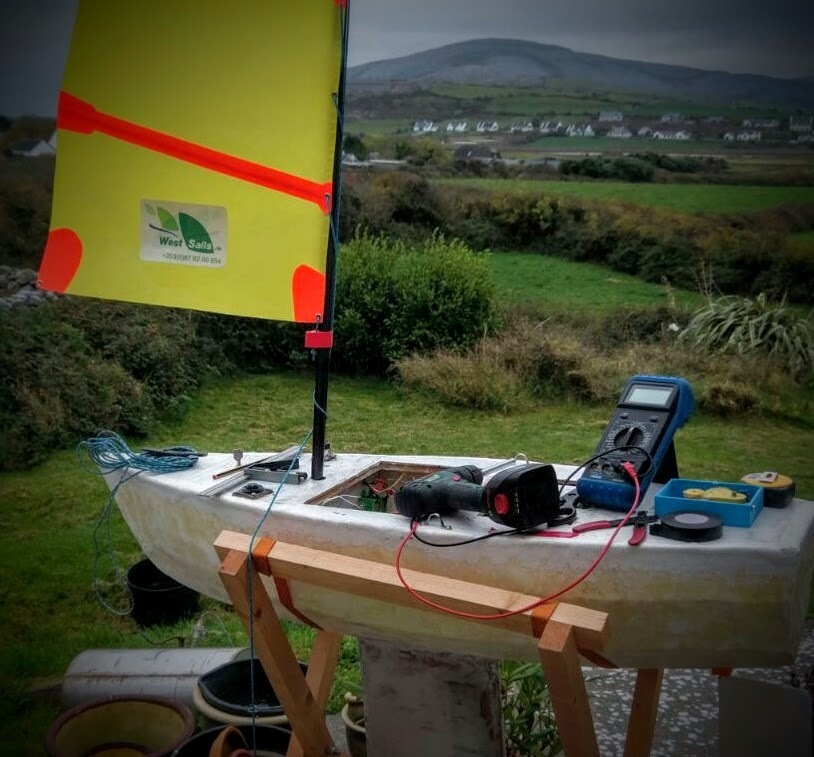Impending Launch.
by Dermot Tynan in Microtransat
Posted on Tuesday, November 01, 2016 at 11:03
Hull #002 is coming along, slowly. The stations are mounted on the strongback and I've been double-checking the alignment. I have time to do this because 1/32nd inch balsa wood is hard to come by, and because I haven't cut the keelson yet. Well, I have, but I need to re-cut it. The original was cut to the wrong profile.
While the work on hull 2 continues, I've been using Hull #001 to test out aspects of the boat design and control systems. In fact, I am very close to launching the hull…
I decided that I needed more real-world data from the hull. Also, I need a test platform for the wing sail which will be used on hull 2. Finding the right base point for the wing sail is a tricky problem. Too far back and the boat will tend to round up into the wind. Too far forward, and she'll bear away dramatically. If you want to know why this is, leave a comment below.
As the mast is keel-stepped, this means that I need to drill a 21mm diameter hole through the deck, for the mast. Put the mast in the wrong place, and it's time to drill another hole. The easiest solution to this is to use hull 1 as a test boat.
Because it won't do any long-distance missions, it doesn't have the same waterproofing needs as the Micro Transat boat. So multiple holes in the deck for mast re-alignment, isn't an issue. It also allows me to test other systems, like the rudder response, the regular sail response, the system for sheeting in and out the main sail, on the water communications, and a whole pile of other things.
Since I decided to launch the test hull, and while I wait for the arrival of some more balsa wood, I've been focusing my efforts on getting the test boat ready for the water. Initially, I will just focus on the rudder activity, and I will tie-off the main sail for a particular point of sail. As I've stated before, it is imperative that the sail be trimmed for the right point of sail, or the boat just won't respond (or even move). But for now, it'll do fine. I can focus on upwind-only testing, or downwind-only testing, etc.
I will put a control board onto the boat for a couple of reasons. Primarily because the radio receiver I have just presents a pulse-width modulated signal output, and I need to drive a stepper motor. But secondly, because this is about collecting telemetry. The more data, the better. I will start by using a 434MHz transmitter on the boat which feeds data back to a ground station for offboard recording. Immediately after I complete these basic steps (in the next week or so), I will add an electronic compass. This will allow me to measure a lot more information about the hull, such as the rate of change of direction as a function of wind speed and rudder angle. For example, with the main sail pulled in completely, and sailing upwind in 10 knots of breeze, how long does it take to take from one side to the other?
The next stage will be to arrange for the main sail to be adjustable under program control. Traditionally, remote control boats (like the IOM boats) use capstan servo motors to wind in or let out sail. I have concerns about systems like this when it comes to Atlantic crossings, because I'm worried about water ingress into the servo. However, it's fine for testing purposes. Rather than use a hobby servo, I am instead using a stepper motor with a 3D-printed winch. The other end of the line will be connected to a length of bungee rope. This keeps the correct tension on the winch drum, and also makes sheeting out that bit easier. The line will connect via a pulley to the boom. At this point I'm unsure about how to detect the "zero position" of the stepper motor, but I'll cross that bridge when I come to it.
Once the boat can sail (by remote control) using both the rudder and the mainsail, I'll add a small GPS unit. At that point, it will be possible to sail autonomously, at least for short distances, anyway.
You may be wondering how I intend to detect wind direction. In the past, I have developed a couple of different systems for measuring wind direction and I can't say that I have the ideal system as-yet. For the test hull, I will use the "mission start" switch to indicate that the boat is head to wind. The technique is quite straightforward. I place the boat into the water, and point it exactly into the breeze. Then, I push the "mission start" button and the control software will read the compass to detect the current wind direction. While this technique doesn't allow for gusts or wind shifts, it provides a very crude indicator which can be used to autonomously sail the boat until I have something more elaborate.
Search
Upcoming Missions
- Galway Bay Loop, Waiting for Vessel Availability
Recent Posts
- May 2023 (1 post)
- April 2023 (1 post)
- March 2023 (1 post)
- February 2023 (2 posts)
- March 2022 (3 posts)
- March 2021 (1 post)
- August 2020 (1 post)
- May 2019 (1 post)
- April 2018 (1 post)
- November 2017 (1 post)
- April 2017 (1 post)
- November 2016 (1 post)
- September 2016 (1 post)
- August 2016 (1 post)
- January 2014 (2 posts)
- October 2013 (7 posts)
- September 2013 (1 post)
- August 2013 (3 posts)
- June 2013 (3 posts)
- May 2013 (4 posts)
- April 2013 (3 posts)
- March 2013 (9 posts)
- February 2013 (8 posts)
